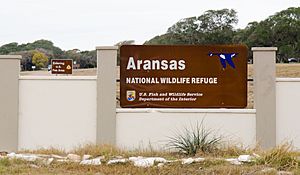Aransas National Wildlife Refuge facts for kids
Quick facts for kids Aransas National Wildlife Refuge |
|
|---|---|
|
IUCN Category IV (Habitat/Species Management Area)
|
|

Wetlands at Aransas National Wildlife Refuge looking out from the 40 ft observation tower.
|
|
| Location | Aransas, Calhoun, Refugio counties, Texas, United States |
| Nearest city | Austwell, Texas |
| Area | 115,324 acres (466.70 km2) |
| Established | 1937 |
| Governing body | U.S. Fish and Wildlife Service |
| Website | Aransas National Wildlife Refuge |
The Aransas National Wildlife Refuge is a very large protected area in Texas, United States. It covers about 115,324 acres, which is a huge space for nature! This special place is located on the coast of Texas, right next to San Antonio Bay and the Gulf of Mexico. It stretches across parts of Aransas, Refugio, and Calhoun Counties.
The refuge also includes almost all of Matagorda Island. This is a long barrier island, about 38 miles long. The Aransas National Wildlife Refuge was created on December 31, 1937. President Franklin D. Roosevelt established it. Its first name was the Aransas Migratory Waterfowl Refuge. It was made to be a safe home for birds that travel long distances. It also protects many other kinds of wildlife. In 1940, President Roosevelt changed its name to Aransas National Wildlife Refuge.
Contents
Building the Refuge
In October 1938, a group called the Civilian Conservation Corps (CCC) helped build parts of the refuge. Company 880 of the CCC set up a camp near Austwell, Texas. They worked hard to create many important features.
They built roads and dug ditches. They also made firebreaks, which are clear areas to stop wildfires. The CCC built living areas for the refuge staff. They even constructed part of a spillway for Burgentine Lake. This lake is a major resting spot for many migratory birds.
A Home for Wildlife
The Aransas National Wildlife Refuge is home to many different animals. It has grasslands, thickets of blackjack oak trees, and freshwater ponds. There are also large marsh areas.
Birds
Many types of birds live here or visit during their migrations. You can see:
- Ducks
- Herons
- Egrets
- Ibises
- Roseate spoonbills
One of the most famous birds here is the endangered whooping crane. These tall, white birds were once very rare. Their population has grown a lot since the 1940s, thanks to protection efforts.
Other Animals
Besides birds, the refuge is also home to other interesting creatures. These include:
- American alligators
- Collared peccaries (which look like wild pigs)
- Different kinds of snakes
- Bobcats
How the Refuge is Managed
The Aransas National Wildlife Refuge is managed by the United States Fish and Wildlife Service. It is divided into five different sections, called units. Two of these units are connected on the mainland. Three other units are separate from the main area.
The original part of the refuge is called the Aransas Unit. It covers 47,261 acres. The Tatton Unit is also on the mainland and is 7,568 acres. The Lamar Unit is 979 acres, and the Myrtle Foester Whitmire Unit is 3,440 acres. The largest unit is the Matagorda Island unit, which is 56,683 acres.
In total, the Aransas National Wildlife Refuge is 115,324 acres. This makes it the largest protected area managed by the Fish and Wildlife Service in all of Texas!
See Also



